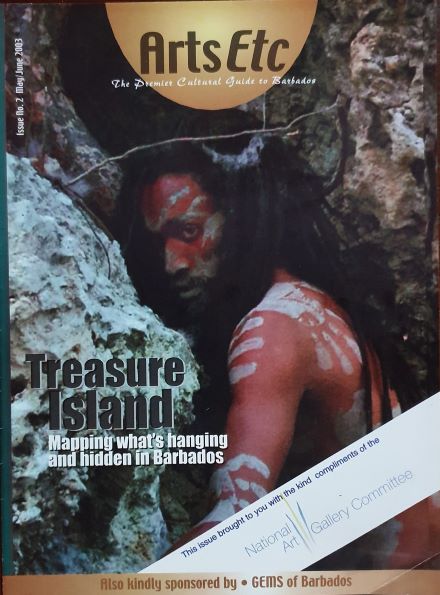
ArtsEtc Inc. 1814-6139
All works copyrighted and may not be reproduced without permission. ©2013 - hoc anno | www.artsetcbarbados.com
All works copyrighted and may not be reproduced without permission. ©2013 - hoc anno | www.artsetcbarbados.com



Published: May/June 2003
Theme: Treasure Island
Cover: Embracing a piece of the Rock is Barbadian poet and actor nala photographed by Walter Bailey.
Contributors: Carolle Bourne, Ridley Greene, Esther Jones, Mark Selman

BackPage Say #2
Not Just Cricket
By Linda M. Deane
BARBADOS isn’t part of an “axis of evil,” any “dictators” are of the benign variety, mostly, and we are famous for our cricket—not our oil. But Barbados shares something significant with the Gulf state of Iraq: our culture, or at least part of it, is under threat.
Iraq, “cradle of civilization,” is home to an embarrassment of riches much of which was at risk in the recent US-led offensive. Barbados, if not a cradle, then a nursery of cricketing civilization, is home to Kensington Oval, a Mecca for players and fans worldwide. The authenticity of this living monument to the sport is threatened not by any “shock and awe” campaign, but by multi-million-dollar redevelopment.
Tamper with that hallowed ground, the stands or the environs to make way for commercial ventures and extra car-parking, and we tamper with contemporary Bajan culture, collective memory and Kensington’s urban context in a way that could come back to haunt us.
When two of this island’s oldest hotels (Sandy Lane and the Hilton) came tumbling down to make way for updated versions, the voices one expected to hear in defiance of the bulldozers—the National Trust, the architects and historians—were strangely mute. Who will step to the crease for Kensington? Maybe some visionary who knows how to relocate the proposed project nearer the airport and the highway, or to some precious tract of land otherwise earmarked for golf. Someone, hopefully, who can intervene the way the British Museum and UNESCO have on Iraq’s behalf.
More common ground: both countries are signatories to the World Heritage Convention—a UNESCO treaty governing the management of the world’s treasures. Barbados signed as recently as 2002; Iraq was among the first, signing in 1974.
Members may nominate aspects of their national heritage for inclusion in a map of world culture. Over 730 sites in 125 countries have met the strict criteria, including Egypt’s pyramids and Dominica’s Morne Trois Pitons National Park. Listing can help raise a country’s profile as a “cultural destination” and attract visitors—great news for tourism-based economies. Listing also qualifies sites threatened by natural or man-made disaster (be it hurricane, war or developers’ plans) for protection under the World Heritage in Danger List.
Years of instablility have made data gathering to UN standards difficult in Iraq. That’s why only one cultural site (the ancient city of Hatra) is inscribed on the World Heritage List and why most of Iraq’s riches were vulnerable once bombs and art thieves were let loose.
Barbados, as a new signatory, is only in the early stages of identifying sites for nomination. An expanded definition of cultural heritage means that sites connected to our slave past are now eligible. Who knows what space awaits on a future World Heritage map for sites that constitute an accurate, authentic and well-preserved record of cricket’s significance to regional development?
What pity it would be to run ourselves out of this particular history book before the first ball is even bowled.
Linda M. Deane is the founding editor with Robert Edison Sandiford of ArtsEtc.